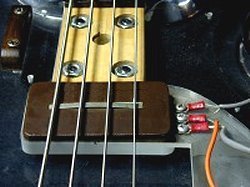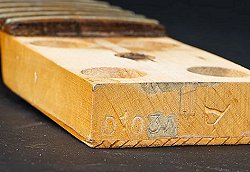
For the origins of the Dan Armstrong bass, it is highly recommended to first read through the guitar section, for with
the guitar prototype completed, building the bass guitar was going to be a somewhat easier task as Dan & Matt didn't
have to "invent the wheel" all over again. Like the guitar model the bass prototype was all hand built by Matt Umanov and
although the overall body dimensions were identical the routing within the body needed to be changed as unlike the guitar model, the
bass guitar did not utilize interchangeable type pickups. Thus the largest difference between the guitar body and the bass body is the
noticeable lack of the sweeping pickup channel in the body.

|
As a result of this difference the routing of the control cavity had to be different. And it was here that Dan
delegated the project out to Kurt Munkacsi, who stated "I only got in on a small part of the plexiglas instruments as Dan gave
me the project of finding a way to hook up the bass pickup to the volume and tone control wiring."
Kurt designed it so that there was a small section of the control cavity that wasn't routed as deep
as the rest, giving the ability to allow a good mechanical, and electrical connection from the
pickup to the rest of the instruments circuitry.
|
At left and right, one of the earliest known Dan Armstrong basses to leave the production line at Ampeg, sporting the serial number D103A.
Dan himself told me that "anything prior to D100A was a prototype". This is not to say that there are 99 prototypes, but rather to
avoid any confusion on the matter, he just started the actual production number at 100 on both the guitar and bass models. This bass is the
earliest model I have seen to date. All photos are courtesy of Sales GuitarPoint Vintage Guitars.
At left, and not surprising is the existance of what Dan called a 'pickup plate' - a chrome plated plate that secures the bass pickup in place
and anchors to the acrylic body using two chrome plated screws. Somewhat surprising is the rosewood saddle with a fret residing on it as these
type of saddles did not exist at the time this bass was made. Without a doubt, this was added later. At right, and like all other early bass
models, notice how the rosewood thumb rest is placed further back towards the pickup. Future models would have the thumb rest centered relative
to the upper portion of the scratchplate.
At left and right, not native to this or any Dan Armstrong bass is the existance of darker brown colored rings around the volume and tone
controls and a black washer under the output jack.
At left and right, the bass photographed with it's hardshell case. Given such an early model I cannot say if it's original to the instrument
or not.
At left and right, front and back views of the headstock.

|
At left, and most interesting is the placement of the serial number of this bass. Seen here it is stamped into the bottom of the tongue of the
neck. Notice the lack of any ink within the numbers and letters. Notice too, the stamped in letter sporadically seen on the necks of early guitars
and basses. On this model, it appears as the letter 'A' seen upside down. Lastly, seen at the bottom of the tongue of this neck, notice a thin
strip of maple with a pronounced grain to it. It's as though the tongue was built up, a bit, like a shim of sorts.
|
At left, another very early bass. Notice the light blue lining of the case - which is a common theme among the earliest cases - save the D103A
model shown above. In addition to the light blue lining, notice too the addition of contoured side bolsters to cradle the instrument.
Seen better in the enlarged view, notice straight headed screws securing the tailpiece to the body. Notice too, an un-sandblasted
tailpiece and a somewhat wider, oversized rosewood saddle compared to later models. But the real surprise, to me, is the white
etched-in lettering on the scratchplate - which shows the Dan Armstrong name only - the Ampeg name surprisingly missing.
At upper right, and also seen best in enlarged view, a very odd shaped, and deeper routed control cavity. Notice the aluminum foil type
shielding applied to the bottom side of the scratchplate. This is another common theme among the earliest made basses. Why this practice
was discontinued is unknown. Perhaps Dan (or Ampeg) thought it didn't make enough of a difference to continue with it.
Another oddity can be seen where the pickup resides in the acrylic body. Seen here from the backside, notice a small strip of what appears
to be a piece of the faux-wood scratchplate material residing underneath the pickup. It is unknown for certain, but a good guess is that
it is being used as a spacer, to build up the height of the pickup - which would seem to suggest that maybe the pickup cavity was routed too deeply.
At upper left, another indicator of a very early bass model - a chrome plated plate that utilizes two screws driven into
the body to help secure the bass pickup in place. The pickup itself gives signs of an early model, for if you look closely
you will notice that it is totally encased in resin. While this is not uncommon, what is uncommon, is, that even the metal
pole piece is encased with that resin. Seen better in enlarged view is another oddity of sorts. Notice how the scratchplate
curls up a touch just before it meets with the chrome plated pickup retaining plate.
At upper right, a black plastic thumb rest is equipped on these early models, whereas later models sport rosewood type thumb rests.
Unknown to many is that on these early models the thumb rest is not centered on the top portion of the scratchplate, but rather
are located further back, toward the pickup.
At upper left, the large flared-out shoulders of the headstock are quite bold when compared to later models, while at upper right, and as seen
from the backside, the flared shoulders are even more obvious. Also notice how the low 'E' string tuner has been fitted out with a Grover Rotomatic
tuner, whereas the rest the original Schaller tuners. Notice too, the use of Phillips screws on these tuners.
At upper left, the same bass in an indoor setting. Notice again - only the name Dan Armstrong on the scratchplate.
Notice too, the lack of any beveling in the cutaways like later models feature. At upper right, and seen from the
backside, again the faux-wood material can be seen under the pickup. Like the guitar model, these earlier made basses
feature a smaller type channel in the body that was routed for the ball-end of the strings to reside in. By the late 1970s
the channel would be enlarged - both on the bass and guitar models. Notice again the placement of the thumb rest and
the aluminum foil shielding that has been added behind the scratchplate.
An early 1969 Dan Armstrong bass bearing the serial number D146A which, according to Dan, makes it the 46th bass that rolled off the
assembly line at Ampeg. Notice that this bass features a case with a light blue lining and a snap down pick compartment, as well as the early, and
more squared off shaped carrying handle. Notice the string mess up by the tuners at the headstock.
Above left, and not surprisingly, this bass features what Dan called a 'pickup plate' to help hold the pickup in place. Seen
better in enlarged view, notice the thumb rest. Not only is it placed further back, but you may have noticed that it is
slightly off, turned up ever so lightly towards the upper horn. At right, and equally seen better in enlarged view, notice
the fairly straight grain of the scratchplate.
Above left, like most of the early basses, this one has foil on the backside of the scratchplate. Above right, the CTS pots
show a date of 1969.
At left and right, notice (when compared to later models) the oversized headstock. Back on the left, notice the aforementioned black silk material
on the strings, used to protect the chrome plating on the tuners. While its common to see this material - what is not very common is to see this
material in the nut. Seen here, the silk wrapping on the 'G' string is so far back that it's actually in the nut and would interfer with with tone,
string action and likely the intonation. A razor knife and a bit of elbow grease would fix this problem. At right, take notice of the straight
slotted screws that help to secure the tuners in place - as well as all Schaller tuners - unlike the photo of the headstock on the bass
shown further above that features Phillips screws.
Above left, and like the D103A bass shown further above - apparently the very early models have their serial numbers stamped into the bottom of
the tongue rather than on the side like later models. To the right of that is the aforementioned stamped in letter seen sporadically on early,
made instruments. Unlike the upside down 'A' seen earlier, this one appears (as I call it) the letter 'G' which, in this photo appears to be lying
on its side relative to the serial number. Again, notice no ink within the stamped in numbers and letters. I've tried to make sense of these
additional letters and checked with all my contacts, but to no avail. I often wish I had asked Dan about it but I'm not sure if he would have known
or not. As such, if nothing else, their presence serves as a way to authenticate an early made neck.
At right, talk about case candy! An original owner registration card, purchase slip and receipt showing the date of November 28th
of 1969 while the owner registration card shows a date of December 6th of 1969 - about a week or so after the actual purchase
which sounds about right.
Another very early bass guitar featuring a case with a light blue inner lining. Notice how the blue lining is beginning
to separate from the top cover of the case. Notice how the case also features the more squared off handle and leather strap
that secures the lid of the pick compartment.
At upper right, the squared off handle features a metal base portion that can be seen here. These features would
soon give way to a newer style case featuring a more rounded off handle and a metal hook inside replacing the leather strap that
secures the lid to the pick compartment.
continue
menu
Names and images are TMand © Dan Armstrong / Ampeg. All rights reserved.
All other names and images are TMand © of their respective owners. All rights reserved.
|
| |

